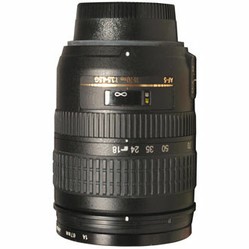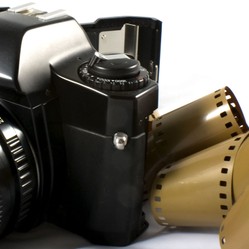The lens mount is the metal housing which holds the assembly of glasses making up lenses. Lens mounts on some cameras are fixed and non-interchangeable.
There are five principal types of lens mount: standard, sunk, collapsible, between-lens shutter types and focusing mount. There are also several varieties of the last-named type.
On a standard mount, the flange screw is near the back of the lens barrel so that most of the lens projects from the front of the panel when it is screwed home. This type of mount is sometimes called an iris mount because it is convenient for the fitting and adjustment of the iris diaphragm. The standard type of mount adds its length to the existing camera extension and is useful in keeping down the over-all dimensions of the camera. Lenses for stand and studio cameras usually have standard mounts.
On a sunk mount, the flange screw is placed as close to the front end of the lens barrel as possible, leaving only a narrow rim to take the lens hood or filters. This type of mount is fitted on reflex cameras; it looks neater and gives the lens better protection than the standard mount, but it calls for more camera extension. The iris diaphragm in this case is controlled by a rotating ring on the front of the mount.
A collapsible mount is simply a standard mount that allows the lens to be pushed back into the body of the camera when not in use. It forms a convenient way of providing the necessary camera extension for the short focus lenses of miniature cameras. The lens barrel can be locked in the forward working position by pulling it put and turning it to engage a bayonet catch. This type of mount may also incorporate the focusing mechanism.
The between-lens shutter mount is found on the majority of hand cameras. The lens components are actually fitted by the manufacturer so that in effect the lens is sunk into the shutter mechanism and the blades of the shutter and the leaves of the iris diaphragm lie between the front and back components.
 | Sony 18-200mm F3.5-6.3 E-Mount Lens E-mount 18-200mm F3.5-6.3 OSS LE |
 | Fotodiox Lens Mount Adapter, Nikon Lens to Canon EOS Camera Body, for Canon EOS 1D, 1DS, Mark II,... The Fotodiox Nikon-Canon Lens adapter allows you to place your favorite Nikon lens on your Canon EOS body. This adapter gives you the ability to use your irreplaceable prime len... |
 | Fotodiox Lens Mount Adapter, Minolta MD/MC Rokkor Lens to Sony Alpha A-Mount Camera, for Sony A10... The Fotodiox Minolta MD/MC Rokkor- Sony (a) Lens adapter allows you to place your favorite Minolta MD/MC Rokkor lens on your Sony Alpha A-Mount camera body. This adapter gives y... |
Cine Camera Mounts
Most cine cameras have a standard screw mount and the lenses are usually interchangeable. Two widely used standard mounts are the Type C for 16 mm. cameras and the Type D for 8 mm. The Type C mount has a diameter of 25.4 mm. (1 inch) with thirty-two threads per inch and a flange-to-film distance of 17.5 mm. (0.69 inch).
The Type D mount for 8 mm. cameras has a diameter of 15.8 mm. (0.632 inch) with again a pitch of thirty-two threads per inch and a distance of 12.3 mm. (0.484 inch) from the lens flange to the film. There are, however, also a number of non-standard mounts for specific cine cameras which can then be used only with the lenses designed for them.
Bayonet Mount
On a number of cameras, especially 35 mm miniatures and roll film reflexes, the lens is fitted to the camera by a bayonet mount. This permits quick lens changing, since only a quarter turn or half a turn is required to position the lens. Usually a catch secures the lens in position, and has to be pressed or disengaged before the lens can be removed or changed.
Bayonet mounts are rarely standardized, partly because the flange-to-film distance tends to vary from camera to camera. So even when one lens fits the mount of another camera, there is no guarantee that the lens will be positioned at the correct lens-to-film distance. Sometimes different cameras using bayonet-mounted lenses by the same manufacturer deliberately have different "keys" to the bayonet mount to prevent a lens from being used on a camera other than that for which it has been designed and set.
On some 35 mm rangefinder cameras the bayonet mount engages a mechanism which automatically changes the image frame of the viewfinder to match the focal length of the lens. Focusing Mounts. In a focusing mount the lens barrel is mounted in a housing which is screwed or slotted to allow the lens to be focused by sliding or turning it in the mount. The most usual system is the helical mount which screws the lens in and out by means of a coarse screw thread.
Occasionally lenses may have a dual focusing mount with two (or even more) helical threads and separate lens tubes for each to give a greater range of lens-to-film distances. This is useful for extra close focusing and such macro mounts (available for certain miniature still and narrow-gauge cine cameras) permit focusing down to a few inches.
Filter Mounts
The front mount of a camera lens if frequently designed to hold filters securely. The simplest way is to finish the front mount with a plain rim which then takes push-on filter fittings. These are easy to attach or remove, but not very secure.
The majority of camera lenses carry a screw thread on the front for screw-in filters in various standard diameters. A few cameras have a bayonet front mount to take bayonet mounted filters which are quick to attach or remove, yet secure in position.
The front lens mount is equally intended for taking supplementary lenses in their appropriate mounts or fittings.
You might also like
Camera RepairTips for Photographing SculpturesPhotographing sculptures calls for as great, if not greater, skill in the use...




 Photographic Styleon 10/14/2011
Photographic Styleon 10/14/2011
 Interchangeable Lenseson 09/28/2011
Interchangeable Lenseson 09/28/2011
 Negative Blisters and Blemisheson 09/17/2011
Negative Blisters and Blemisheson 09/17/2011
 Photographyon 08/22/2011
Photographyon 08/22/2011



Comments